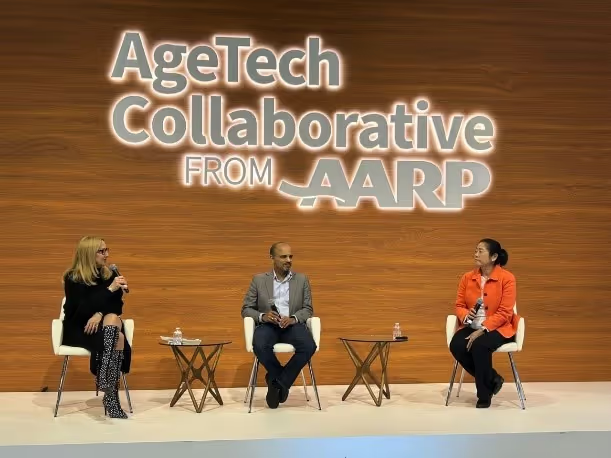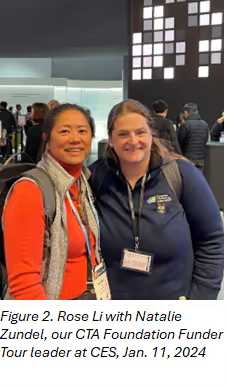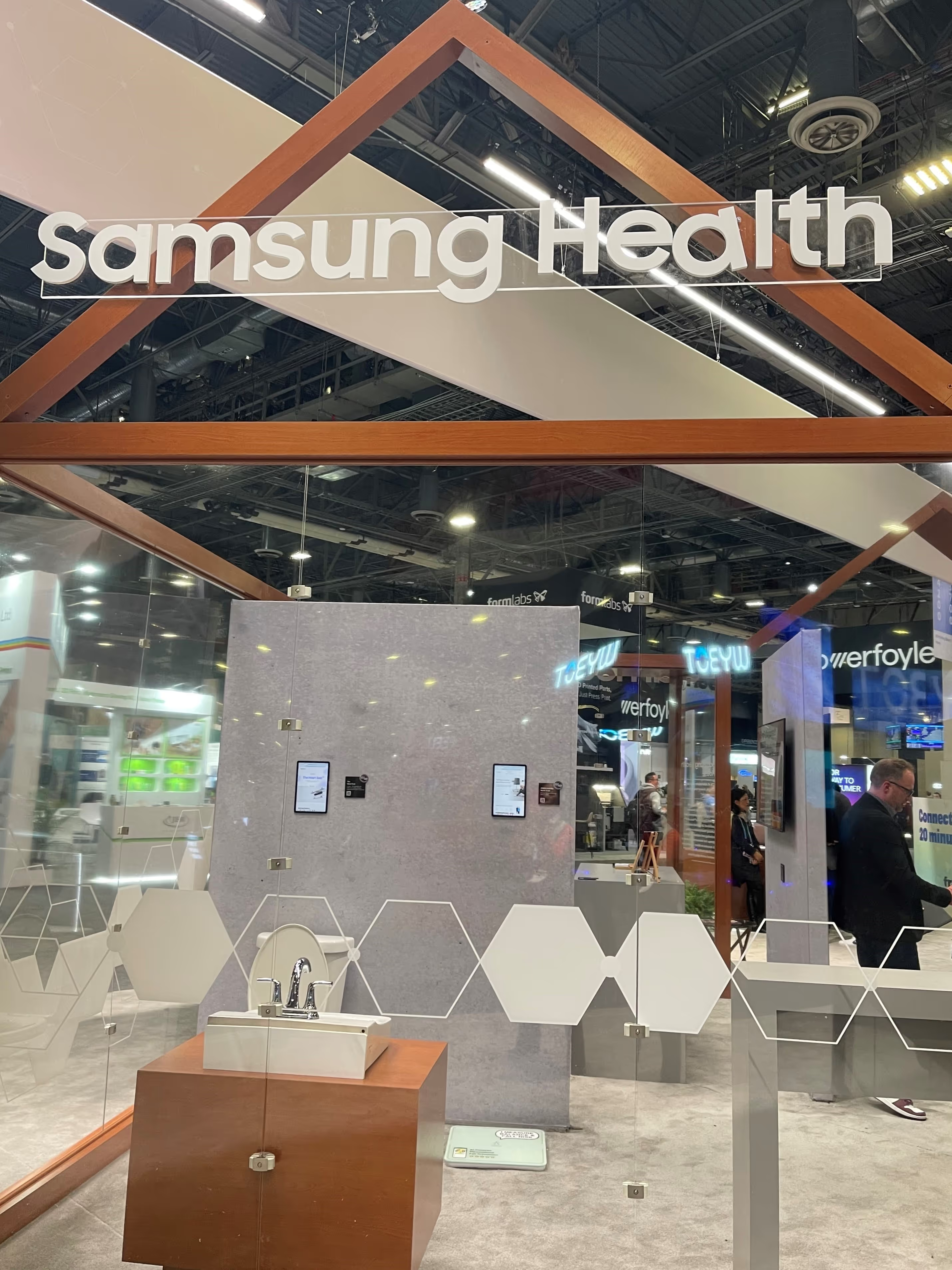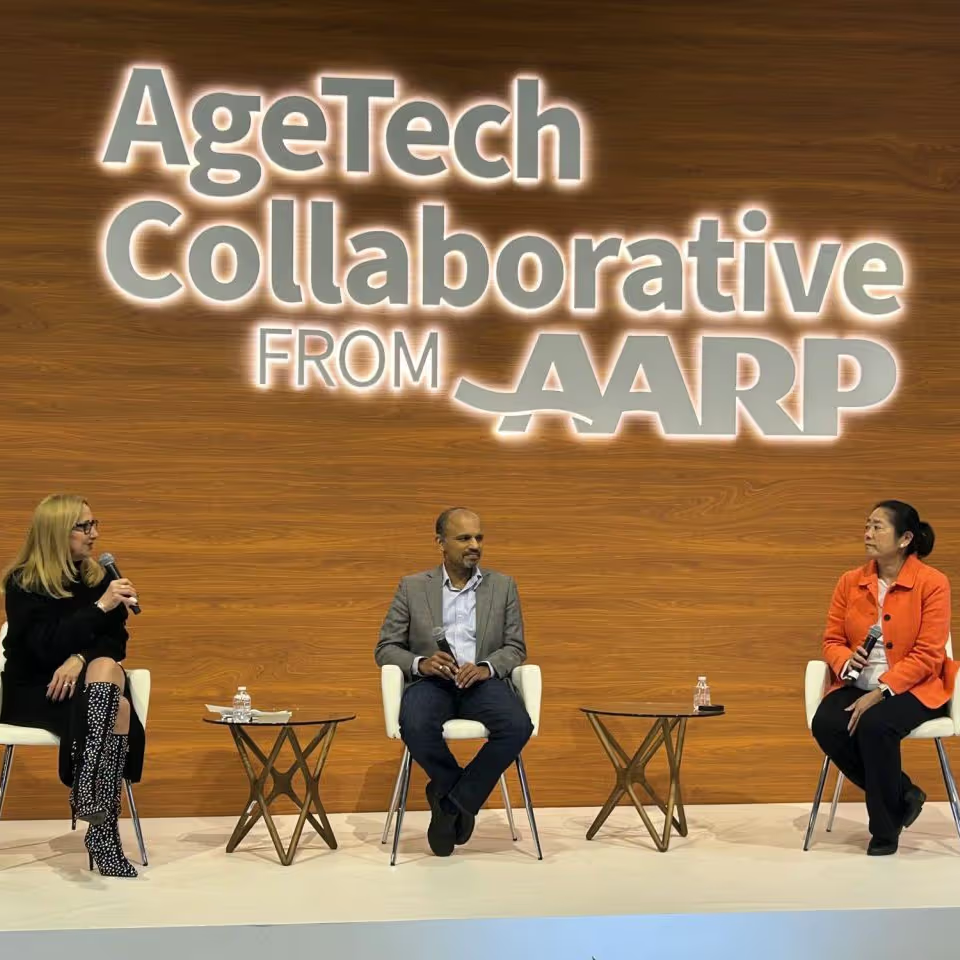Editorial note: The a2 Collective was pleased to join AARP’s AgeTech Collaborative at CES in both 2023 and 2024. This year, a2 Collective Coordinating Center Principal Investigator Rose Li, PhD, MBA, participated in an AgeTech Collaborative panel and shared her key takeaways from the event below.
As a first-time attendee of the Consumer Electronics Show (CES)—held Jan. 9-12, 2024, in Las Vegas, NV, with more than 135,000 attendees, 1400 startups, and 4,300 exhibitors—I was expecting to be blown away by cool gadgets and over-the-top exhibits. CES didn’t disappoint, and the multitude of innovations geared toward an aging population was head-spinning. AARP’s AgeTech Collaborative led the charge, with a commanding exhibit presence that featured selected startups, a dedicated event stage, and a Samsung Health House outfitted with cutting-edge innovations to help older adults in their living, sleeping, and toileting. Danielle Duplin moderated multiple sessions in a great lineup of speakers that helped to synthesize the vast amounts of information, devices, and applications scattered throughout multiple large venues.

As the head of the coordinating center for the Artificial Intelligence and Technology Collaboratories (AITC) for Aging Research program funded by the National Institute on Aging (NIA), part of the National Institutes of Health (NIH), I am committed to accelerating innovations that can help older adults live longer and healthier lives wherever they choose. At the AI Breakthroughs for Aging Better session at the AARP AgeTech Exhibit on Jan. 9, I was delighted to share a sense of the pilot awards that the a2 Collective has funded most recently. We have received nearly 700 applications from 45 states and Washington, DC, Puerto Rico, and the U.S. Virgin Islands. Our program is distinctive in the level of academic rigor reflected; more than 70% of our awards go to teams with academic collaborators, often bringing technologists and researchers together across sectors and disciplines. Of the awards made in the past 2 years, nearly 90% involve machine learning, 60% feature user-facing software and platforms, and a majority address cognition including dementia. More than 70% of our awards are in diagnostics, treatment, and care; the rest are in research and prevention. During the session, I was excited to announce that details of projects funded in the second a2 Pilot Awards cohort are now available and that we have two more competitions on the horizon, with Round 1 deadlines on April 30, 2024, and Jan. 15, 2025. Deepak Ganesan, co-director of MassAITC, spoke about future directions for the program and the field, highlighting his pioneering work in mobile health and wearable computing.

Another bright spot at CES was the Consumer Technology Association (CTA)-organized “funders tour” to help curate the voluminous AgeTech-relevant innovations and innovators worth noting. Natalie Zundel had the unenviable job of trying to herd us cats, when there was temptation everywhere to learn/touch/interact with something new. Steve Ewell, CTA Foundation executive director, accompanied us and shared his enthusiasm for understanding market trends.
Here are some highlights from that tour:
– Stacey Dubowitch-Maslyn shared her love for delivering therapeutic music for stroke therapy, improving cognition for older adults, and reducing emotional outbursts of Alzheimer’s patients through SingFit (Los Angeles, CA).
– Knowing there is a shortage of caregivers throughout the country, as in many other countries ahead of us in population aging, I’m cheering on inventors of robots that can interact with older adults and their caregivers, especially ones that can render help and sub in for caregivers stretched too thin. It was exciting to see so many robots continuing to be perfected to improve the older adult care experience. Although there are only a limited number in circulation, Labrador’s (Calabasas, CA) assistive robots are already being tried in targeted living facilities, and at a price point of about $300/month for a service contract, these promise to be game changers in more homes—helping with laundry, delivering meals, carrying in firewood—if the company can scale up in the coming year. Futronics (Pasadena, CA) has an autonomous walker that can help with physical therapy and other robots that can deliver meals and medications in institutional settings as well as at home.
– EssilorLuxottica (Italy) is marketing the Nuance Audio glasses-based hearing aid for mild hearing loss, which uses a microarray beamformer to only amplify the voice of a person speaking 3-6 ft directly in front of the glasses. They’re marketed to look exactly like a regular pair of eyeglasses with nothing inserted into or around the ear to avoid any potential stigma of an assistive hearing device. They are expected to be priced around $1,000 and work quite effectively. TranscribeGlass (Cupertino, CA) offers a much more cost-effective alternative (expected to be a couple hundred dollars); it uses AI technology to help empower people with hearing loss (most of whom are age 65+) to see real-time transcription as heads-up captions for any conversation and boasts 10,000+ pre-orders.
– MindMics (Cambridge, MA), a pilot awardee of the a2 Collective, recognized that many people wear earbuds for much of the day, so have integrated cardiovascular sensors into their high-fidelity earbuds. Founder Anna Barnacka explained that whether listening to music or on a virtual call, users will be able to acquire continuous, long-term cardiovascular data more robustly than from typical wrist-worn devices.
– Accurate Meditech (Taiwan) demonstrated their wearable cuffless blood pressure monitor, the Accurate Mini, which continuously measures blood pressure, oxygen saturation, and core body temperature. Tracking blood pressure continuously or throughout the day is important for many older adults and Alzheimer’s patients dealing with hypertension, to properly titrate their medications. The company has partnered with Enovix, which has developed a silicon-based battery that lasts an impressive 4 months on a single charge. Their Accurate Mini device is Class II FDA approved and will be the only device of its kind available for sale in United States this year.
– With all the small inventors innovating out there, I applaud Hon Pak (VP, Samsung Electronics) and Samsung’s efforts to promote an ecosystem (SmartThings) that offers a platform to incorporate new innovations led by startups, where Samsung can help deal with security, privacy, and data sharing issues. These are all concerns that can prove challenging for startups to address and sustainable, translational solutions are urgently needed. The longer we can let innovators innovate, the more likely we all are to benefit from their great ideas. I was also happy to reconnect with healthcare veteran Ken Honeycutt, director of Samsung Health, who is passionate about AgeTech-wired smart homes. The Samsung Health House illustrated how impactful technologies integrated in the home can be in empowering older adults to live independently while enhancing their quality of life, a key goal for our program and AgeTech at large.

What I enjoyed most was interacting with so many curiosity seekers like myself—testing out prototypes and asking lots of questions, looking for “Aha!” moments of awe and inspiration. For me and thousands of attendees, the innovation showcased throughout CES reinforced the promise and rapid progress of cutting-edge technologies with the potential to transform approaches to health and aging. It’s exciting to think that the innovators behind them are already at work shaping what’s next.




